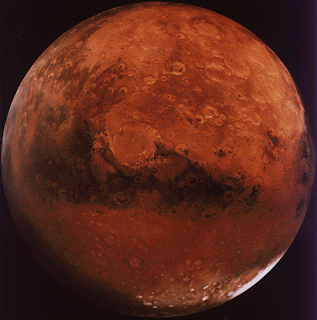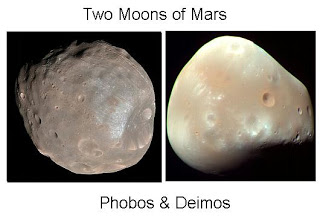Astronomy

Mars is a small rocky body once thought to be very Earthlike. Like the other terrestrial planet?Mercury, Venus, and Earth?its surface has been changed by volcanism, impacts from other bodies, movements of its crust, and atmospheric effects such as dust storms. It has polar ice caps that grow and recede with the change of seasons; areas of layered soils near the Martian poles suggest that the planet's climate has changed more than once, perhaps caused by a regular change in the planet's orbit.
Martian tectonism, the formation and change of a planet's crust, differs from Earth's. Where Earth tectonics involve sliding plates that grind against each other or spread apart in the seafloors, Martian tectonics seem to be vertical, with hot lava pushing upwards through the crust to the surface.
Periodically, great dust storms engulf the entire planet. The effects of these storms are dramatic, including giant dunes, wind streaks, and wind-carved features.
Mars has some remarkable geological characteristics, including the largest volcanic mountain in the solar system, Olympus Mons; volcanoes in the northern Tharsis region that are so huge they deform the planet's roundness; and a gigantic equatorial rift valley, the Valles Marineris. This canyon system stretches a distance equivalent to the distance from New York to Los Angeles; Arizona's Grand Canyon could easily fit into one of the side canyons of this great chasm.
Mars also has two small moons, Phobos and Deimos. Although no one knows how they formed, they may be asteroids snared by Mars's gravity.
Some of the latest Mars information comes from five active probes on or in orbit around Mars including three orbiters and two rovers. This includes 2001 Mars Odyssey, Mars Express, Mars Reconnaissance Orbiter, Opportunity rover, and Curiosity rover.Dozens of unmanned spacecraft, including orbiters, landers, and rovers, have been sent to Mars by the Soviet Union, the United States, Europe, and Japan to study the planet's surface, climate, and geology. The public can request images of Mars via the HiWish program.. The Mars Science Laboratory, named Curiosity, launched on November 26, 2011, reached Mars on August 6, 2012 UTC.



- Sky Watching Dec 18 - 25
Sky Watching 2012,December,18-25 Tue., December 18, 4 a.m. Ceres at opposition...
- Planet - Mars
Mars Mass : ...
- Do You Know - 3
Do You Know? - 3 1 . What is the name of the 2nd biggest planet in our solar system? Ans: Saturn ...
- Picture Of The Day Oct - 25
Picture Of The Day October 25 , Thursday The Cone Nebula (NGC 2264) ...
- Picture Of The Day
Picture Of The Day October 17, Wednesday ...
Astronomy
Planet - Mars
Mars

Mass : 6.4185×1023 kg
Density : 3.93 g/cm³
Length of day : 1d 5h 5m
Gravity : 3.711 m/s²
Distance from Sun: 227,900,000 km
Orbital period : 687 days
Martian tectonism, the formation and change of a planet's crust, differs from Earth's. Where Earth tectonics involve sliding plates that grind against each other or spread apart in the seafloors, Martian tectonics seem to be vertical, with hot lava pushing upwards through the crust to the surface.
Periodically, great dust storms engulf the entire planet. The effects of these storms are dramatic, including giant dunes, wind streaks, and wind-carved features.
Mars has some remarkable geological characteristics, including the largest volcanic mountain in the solar system, Olympus Mons; volcanoes in the northern Tharsis region that are so huge they deform the planet's roundness; and a gigantic equatorial rift valley, the Valles Marineris. This canyon system stretches a distance equivalent to the distance from New York to Los Angeles; Arizona's Grand Canyon could easily fit into one of the side canyons of this great chasm.
Mars also has two small moons, Phobos and Deimos. Although no one knows how they formed, they may be asteroids snared by Mars's gravity.
Some of the latest Mars information comes from five active probes on or in orbit around Mars including three orbiters and two rovers. This includes 2001 Mars Odyssey, Mars Express, Mars Reconnaissance Orbiter, Opportunity rover, and Curiosity rover.Dozens of unmanned spacecraft, including orbiters, landers, and rovers, have been sent to Mars by the Soviet Union, the United States, Europe, and Japan to study the planet's surface, climate, and geology. The public can request images of Mars via the HiWish program.. The Mars Science Laboratory, named Curiosity, launched on November 26, 2011, reached Mars on August 6, 2012 UTC.

- The tallest mountain in the Solar System is the mighty Olympus Mons on Mars. It rises up 27 kilometers above the surrounding plains. Olympus Mons is a shield volcano, like Hawaii?s Mauna Kea, and formed gradually over billions of years. Some lava flows on the volcano are so young that planetary scientists think that it might still be active.

(Olympus Mons)
- One of the most distinct features on the surface of Mars is the Valles Marineris canyon. It stretches 4,000 km along the equator of Mars, and can be as deep as 7 km in places. If you could move the Valles Marineris to Earth, it would stretch right across the United States.

( Valles Marineris)
- Mars has two, tiny asteroid-sized moons called Phobos and Deimos. Phobos orbits the planet at such a low altitude that it?s going to eventually be torn apart by the gravity of Mars. It will survive as a ring for a few years, and then the debris will rain down on Mars. Scientists disagree on when this will happen. It could happen as soon as 10 million years from now, and no later than 50 million years
 .
.
- Sky Watching Dec 18 - 25
Sky Watching 2012,December,18-25 Tue., December 18, 4 a.m. Ceres at opposition...
- Planet - Mars
Mars Mass : ...
- Do You Know - 3
Do You Know? - 3 1 . What is the name of the 2nd biggest planet in our solar system? Ans: Saturn ...
- Picture Of The Day Oct - 25
Picture Of The Day October 25 , Thursday The Cone Nebula (NGC 2264) ...
- Picture Of The Day
Picture Of The Day October 17, Wednesday ...
